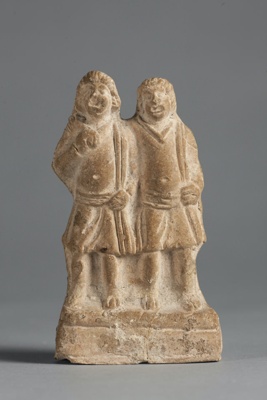< Collection search
< Collection highlights
From:UC Teece Museum of Classical Antiquities
Name/TitleFigurine of two actors as young master and slave
About this objectThis terracotta figurine has been mould made, and depicts two men walking, one supporting the other. The two men have been identified as actors playing a drunken young master and his slave.
The young man has his left hand holding the draped cloth at the level of his waist, while his right hand is on the shoulder of his slave. The slave (who is slightly taller) also has his left hand at his waist and his right hand is on his upper chest, presumably holding his clothing at the neck. Both are wearing chitons, and have cloaks hanging over the left shoulder. Their toes are marked by grooves cut after removal from the mould (their sandals are no longer evident in this version). Their navels are also strongly marked. The youth's head is tilted towards the slave and his body also leans towards him slightly. Both have masks with striated hair. The slave's has short corkscrew curls by the ears; the youth's has long hair reaching to the shoulders. They have flattened, formalised mouths.
Although the figurine is not of outstanding quality, it reflects a major work of art that had considerable importance in the history of the reception of ancient theatre. The piece is an extract from an archetype in the form of a painting, one of a series of key scenes from the plays of Menander, created some time immediately following his death in 292-291 BCE or the following year. The composition of the original survives in two later versions, one a cameo in Geneva of about 100BC or soon after, and the other the well-known marble relief in Naples of perhaps the later part of the first century AD.
With this piece, it is the tilt of the youth's head that reveals his drunkenness. It is unusual to have the slave taller than his young master, since it was normally the convention that a slave should be shown smaller than a free citizen. Although this terracotta should probably date to the first century AD, the Early Hellenistic archetype is reflected in the length of the chitons the figures wear; on stage by this date actors were wearing ankle-length garments (as do all figures but the slave on the Naples relief).
The play illustrated could have been Menander's 'Methe' ('Drunkenness'), although we know unfortunately little of its subject-matter. The centre of manufacture is uncertain but most likely central Italy, possibly Campania.
Date Madeca. 1st Century CE
PeriodHellenistic
Place MadeItaly
Place NotesLikely manufactured in central Italy, possibly Campania
Medium and MaterialsCeramic: Terracotta
TechniqueMolding (forming)
TechniqueModeling (forming)
MeasurementsHeight 136mm
Subject and Association KeywordsTheatre in art
Subject and Association KeywordsTheatre costume
Subject and Association KeywordsFigurative art
Subject and Association KeywordsSlavery in art
Named CollectionThe James Logie Memorial Collection, University of Canterbury, New Zealand
Credit LinePurchased, 1978.
Object TypeFigurine
Object number165.78
Copyright LicenceAll rights reserved
